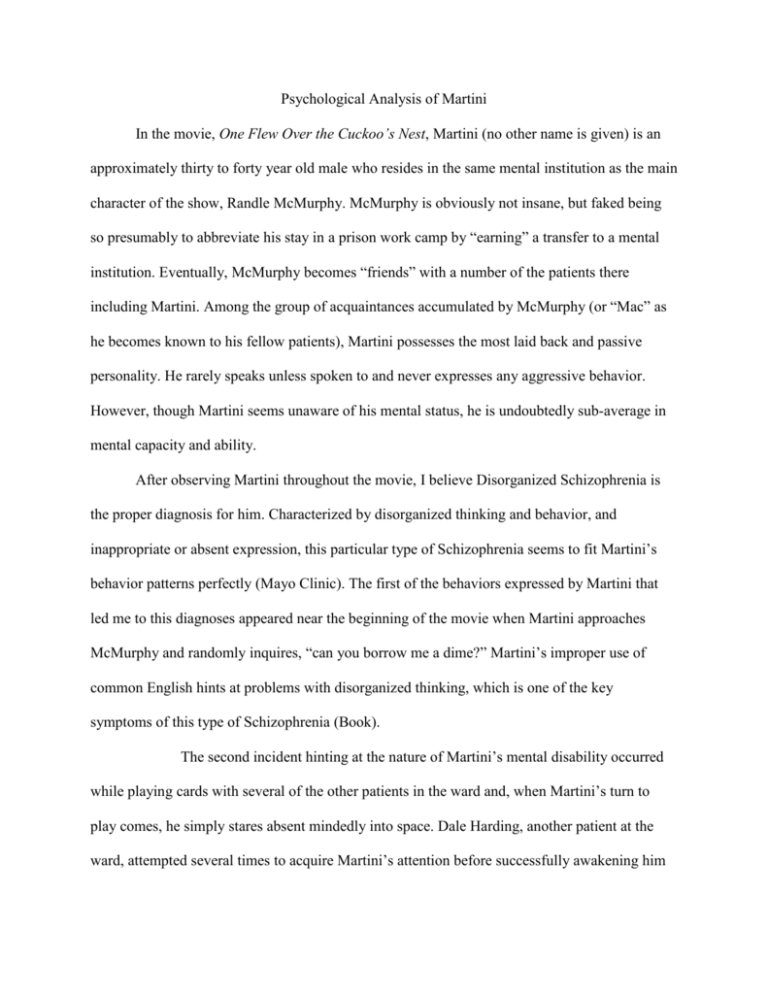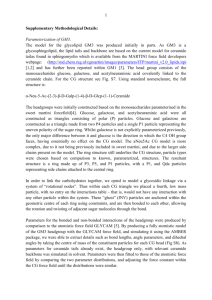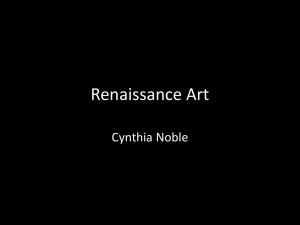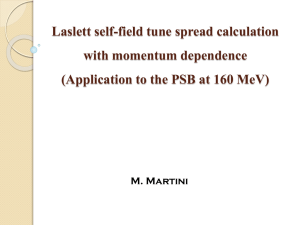Psychological Analysis of Martini Final
advertisement

Psychological Analysis of Martini In the movie, One Flew Over the Cuckoo’s Nest, Martini (no other name is given) is an approximately thirty to forty year old male who resides in the same mental institution as the main character of the show, Randle McMurphy. McMurphy is obviously not insane, but faked being so presumably to abbreviate his stay in a prison work camp by “earning” a transfer to a mental institution. Eventually, McMurphy becomes “friends” with a number of the patients there including Martini. Among the group of acquaintances accumulated by McMurphy (or “Mac” as he becomes known to his fellow patients), Martini possesses the most laid back and passive personality. He rarely speaks unless spoken to and never expresses any aggressive behavior. However, though Martini seems unaware of his mental status, he is undoubtedly sub-average in mental capacity and ability. After observing Martini throughout the movie, I believe Disorganized Schizophrenia is the proper diagnosis for him. Characterized by disorganized thinking and behavior, and inappropriate or absent expression, this particular type of Schizophrenia seems to fit Martini’s behavior patterns perfectly (Mayo Clinic). The first of the behaviors expressed by Martini that led me to this diagnoses appeared near the beginning of the movie when Martini approaches McMurphy and randomly inquires, “can you borrow me a dime?” Martini’s improper use of common English hints at problems with disorganized thinking, which is one of the key symptoms of this type of Schizophrenia (Book). The second incident hinting at the nature of Martini’s mental disability occurred while playing cards with several of the other patients in the ward and, when Martini’s turn to play comes, he simply stares absent mindedly into space. Dale Harding, another patient at the ward, attempted several times to acquire Martini’s attention before successfully awakening him from his dream-like state. To further reinforce my belief that this behavior is in fact a symptom of his mental disorder and not just a one-time occurrence, Martini slips back into his dream state only moments after Harding awakens him the first time. I consider this particular instance conclusive evidence that Martini does, at times, live in his own world. This detachment from reality, also known as psychosis, is another symptom of Disorganized Schizophrenia (Mayo). A third example of Martini’s symptoms appears while he is outdoors on a sort of “recess” and is playing with a basketball. After dribbling the ball aimlessly in circles for several moments, Martini proceeds to pass the ball to an empty portion of the court while simultaneously yelling, “Catch it! Catch it!” This action indicates that Martini is imagining a player where, in reality, no one is present. In other words Martini is experiencing yet another symptom of Disorganized Schizophrenia, delusions (Book). A fourth indicator of Martini’s disorder occurs shortly after Martini passes the ball to the “ghost” player when Washington, an employee at the ward, tells Martini to go get the ball and Martini promptly and forcefully responds, “No!” Assuming that Martini is no longer interested in playing, Washington runs to fetch the ball. As he does so, however, Martini seems to suddenly change his mind and begins yelling, “I get it! I get it!” and begins to chase after Washington in pursuit of the ball. This general inconsistency in his desires suggests, again, disorganized thought processes. A fifth indicator appears at not one singular point in the movie, but rather, throughout the film. Several instances occur where Martini shows a general lack of comprehension in regard to fairly simple tasks. One example of this happens, again, as Martini plays cards with the rest of the gang. In almost every instance when this situation occurs, Martini seems lost and generally lacks knowledge of how the game should be properly played despite frequently repeated efforts of Harding and the others to teach him the rules. This general disorientation is displayed by Martini on several occasions as he often must be told several times to do simple tasks like “pick up my hat.” The final clue, again, comes not in one single scene but throughout the film. About halfway through, I began to notice an abnormality involving Martini’s display of emotions. Or, rather, lack there of. It came to my attention that, no matter the situation, Martini seemed to display the same quirky smile. Even in very emotionally charged scenes such as the one in which Nurse Ratched discovers the wreckage that remained of the previous night’s unauthorized party in the ward, Martini seems unfazed and continues wearing his signature grin. Upon further investigation, I determined that this is indeed a symptom of Disorganized Schizophrenia and is termed the “flat effect” (Mayo Clinic). This final piece of evidence really locked in the diagnoses because Martini now displayed all of the general symptoms of Disorganized Schizophrenia. Though easy enough to identify in this instance, the origins of the disorder are largely unknown. However, scientists believe this form of Schizophrenia is the product of both genetic and environmental factors (Mayo Clinic). Generally, scientists believe neurotransmitters in the brain may contribute to the disorder, and studies that image the brain have shown marked differences between patients with Schizophrenia and those considered normal (Book). However, what these differences may mean is not completely understood. In general, Martini’s prognosis is not outstanding as only 15% of those diagnosed with the disorder recover to the level of functionality they were previous to the onset of the disease (Schizophrenia Prognosis). Several other factors lessen the likelihood he will make a full recovery. The first of which is that Martini is a male, and males generally have lower recovery rates than females (Schizophrenia Prognosis). Another factor that comes into play is the severity of Martini’s disorder. As previously stated, he displayed all of the possible general symptoms associated with Disorganized Schizophrenia also lowering his chances for recovery. The final factor working against Martini’s recovery is the poor support system from the nurses and staff he has at the ward. Numerous other indicators of a prognosis one way or the other may also be present; however, the background information provided by One Flew Over the Cuckoo’s Nest is quite limited on this particular character. Some of these other indicators include a family history of Schizophrenia, a low level of functioning prior to the onset of the disease, and a history of substance abuse, none of which can be determined conclusively from the film (Schizophrenia Prognosis). As for treatments for Schizophrenia, the main options are medications, psychotherapy, hospitalization, and electroconvulsive therapy (Mayo Clinic). In my opinion, two of these treatment options may prove productive for Martini. These are psychotherapy and electroconvulsive therapy. However, the latter is often considered a last resort due to its harsh side effects including confusion, disorientation, and memory impairment (Book). Medication would be largely ineffective because antipsychotics are the only proven medication that work to combat Schizophrenia. These antipsychotics can treat only “positive symptoms,” like hallucinations (Book). Martini’s positive symptoms seem very mild while his major complications lie in the “negative symptom” category like social withdrawal. This leaves one logical treatment option: psychotherapy. In particular, I believe the cognitive behavioral branch would prove most effective. Cognitive therapies in general are based on the premise that distorted ideas about oneself may be manipulated for the better and that behaviors posing a problem to everyday functioning can also be combated. On the other hand, behavior therapies focus on changing the trouble behavior itself and far less on the reasons behind the behaviors (Book). Putting these two terms together then, Cognitive Behavior therapy is a treatment that focuses primarily on the trouble behaviors themselves with the intent of changing them. This treatment seems more appropriate than insight therapies that focus more on the underlying causes for psychological problems because Disorganized Schizophrenia has no definite known cause. Plus, it seems far more appropriate than the treatment he currently receives at the ward consisting of a daily pill (presumably nothing more than a mild sedative) and what appears to be a form of group therapy. Martini seems calm enough as it is and the group therapy does not seem productive for any of the residents of the ward. Even so, I would expect only moderate success from psychotherapy treatment because Martini struggles with comprehension of even the most basic language. This could make communication with the therapist rather difficult. While still not impossible, it does drastically complicate matters. Also, in many psychotherapy techniques, a willingness of the patient to change his or her behavior is crucial for success (Book). Martini displays no such desire for change. Rather, he seems perfectly content to live in his own world in ignorance of reality.







